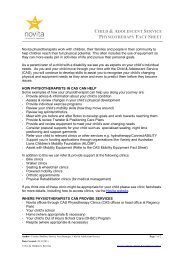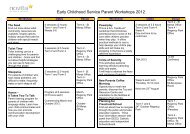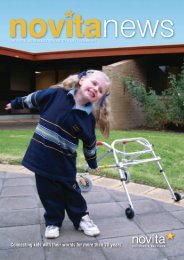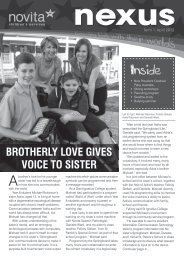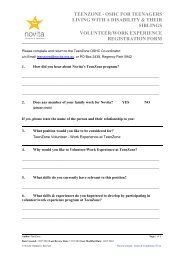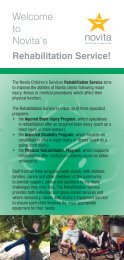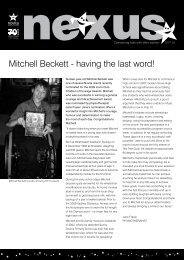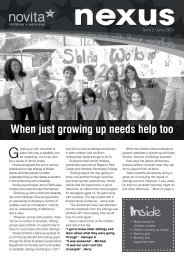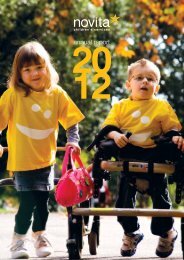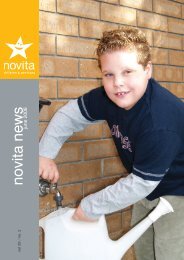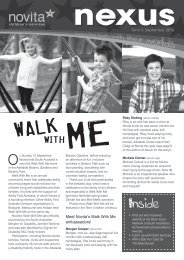Novita Research Report - 2004 to 2007 - Novita Children's Services
Novita Research Report - 2004 to 2007 - Novita Children's Services
Novita Research Report - 2004 to 2007 - Novita Children's Services
- No tags were found...
You also want an ePaper? Increase the reach of your titles
YUMPU automatically turns print PDFs into web optimized ePapers that Google loves.
66ResultsImplicationsStatusThree important fac<strong>to</strong>rs were crucial in the successful provision of solutions <strong>to</strong> theparticipants of the project:1. The key local persons’ role as liaison officers and providing local support <strong>to</strong> trialparticipants was fundamental <strong>to</strong> the overall success of the trial2. The one-day workshop and accompanying Accessible Telecommunications Tools andResources Kit developed during the project, equipped key local persons with the right‘accessible telecommunications’ knowledge and know-how. This provided an array ofsolutions, <strong>to</strong>ols and processes <strong>to</strong> provide an accurate assessment, appropriately matchthe equipment <strong>to</strong> the user, set up the equipment, then train and troubleshoot problems forthe participants during the trials3. In addition <strong>to</strong> the use of the traditional telephone and email service, moderntelecommunications technology such as 3G mobile phones with video talk capability andinternet telephony software with video streaming capability were important for providingcommunication and ongoing support between the participants, key local persons andproject researchers.The research and technology trials demonstrated that through the use of appropriate<strong>to</strong>ols, processes, education, training programs and resources, it would be feasible <strong>to</strong>implement a service delivery model at a remote and national level <strong>to</strong> cater for the accessibletelecommunications needs of people with a disability or the ageing. The outcomes ofthis project show that through the use of modern telecommunications technologies andappropriately trained key local persons, we can use our knowledge <strong>to</strong> remotely assess andsupport the telecommunications needs of people with physical limitations interstate.CompletedProject titleContribu<strong>to</strong>rsSummaryLarge keypad for mobile phone accessRob Garrett, Ben Symonds, Toan Nguyen<strong>Novita</strong>Tech’s <strong>Research</strong> and Development Department has an established track record in thearea of accessible telecommunications, including product development and the identificationof mainstream solutions that can be utilised by people with a disability. When presentingthis work and speaking with key user groups a common request has been for a simple largebut<strong>to</strong>n mobile phone. Similarly, research shows that the ageing would prefer a mobile phonewith larger but<strong>to</strong>ns and simpler functionality (Mann et al <strong>2004</strong>). Telstra have developed alarge but<strong>to</strong>n landline telephone, however a suitable mobile version is not available on themainstream market.Mobile phones allow people <strong>to</strong> remain connected with friends and family and impart asense of security, confidence and independence when venturing out of home. Howeverthe concept of a simple large but<strong>to</strong>n mobile phone unfortunately seems <strong>to</strong> conflict with theproduct development direction of the mainstream market, which is heading <strong>to</strong>wards smallerand smaller phones with increased features and complexity. Therefore this project aims <strong>to</strong>investigate the development of an accessible, simplified, large but<strong>to</strong>n mobile phone solutionthat will meet the needs of those with a disability and the ageing.




